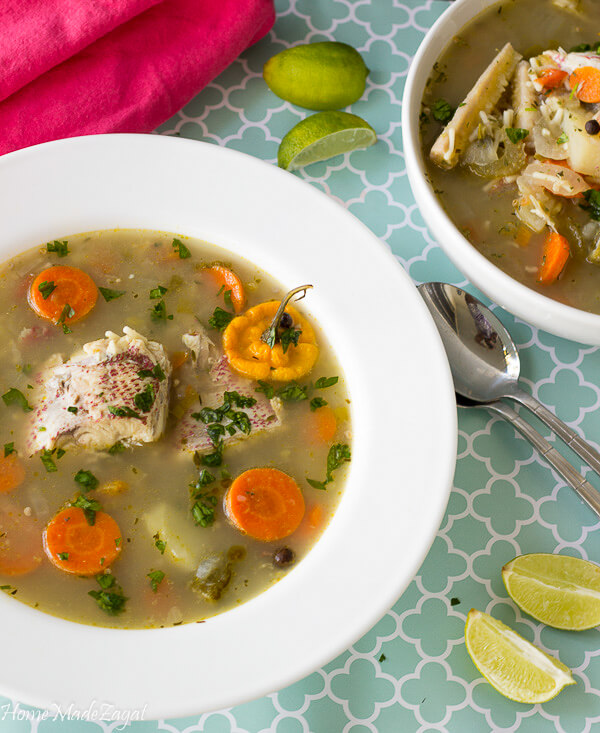Broth has long been savored by many Guyanese, especially in the evenings after a long day, a piping hot bowl of broth usually soothes any stress away. Broth is made in a variety of ways and it consists of various meats such as fish, beef and chicken. This article will show you how to make broth Guyanese style.
Did You Know? ‘Braff’ is the perfect remedy for hangovers (according to Guyanese). After a day of drinking alcohol, the next day is braff!
What Is Broth?
Broth is a savory liquid made of water in which bones, meat, or vegetables have been simmered. It can be eaten alone, but it is most commonly used to prepare other dishes, such as soups, gravies, and sauces. Commercially prepared liquid broths are available, typically for chicken broth, beef broth, fish broth, and vegetable broth. In North America, dehydrated meat stock in the form of tablets is called a bouillon cube. Industrially produced bouillon cubes were commercialized under the brand name Maggi in 1908, and by Oxo in 1910. Using commercially prepared broths saves home and professional cooks time in the kitchen. By 2013, broth labeled as “bone broth” became popularized as a health food trend or fad in certain parts of the United States. Generally, the broth doesn’t have to have spices.
Tip: Bouillon is the French word for “broth”, and is usually used as a synonym for it.
The Difference Between Broth And Stock
Many cooks and food writers use the terms broth and stock interchangeably. In 1974, James Beard wrote emphatically that stock, broth, and bouillon “are all the same thing”. While many draw a distinction between stock and broth, the details of the distinction often differ. One possibility is that stocks are made primarily from animal bones, as opposed to meat, and therefore contain more gelatin, giving them a thicker texture. Another distinction that is sometimes made is that stock is cooked longer than broth and therefore has a more intense flavor. A third possible distinction is that stock is left unseasoned for use in other recipes, while broth is salted and otherwise seasoned and can be eaten alone.
Did You Know? In Britain, “broth” can refer to a soup which includes solid pieces of meat, fish, or vegetables, whereas “stock” would refer to the purely liquid base. Traditionally, according to this definition, broth contained some form of meat or fish; however, nowadays it is acceptable to refer to a strictly vegetable soup as a broth.
Fish Broth Guyanese Style
Fish Broth
Ingredients:
- 12 oz fish (or fish head)
- 1 onion
- eschalot
- celery
- 2 tbsp butter
- cold water
- 1/2 tsp salt
- 1 lb root vegetables
- 1/4 tsp black pepper
- 1 clove
- chopped parsley to garnish
Method:
- Chop onion, eschalot and celery and fry lightly in the butter. Avoid browning, use a cover if necessary.
- Clean fish or fish head, and add to the pan with the water and salt.
- Heat to boiling point.
- Skim, then add the root vegetables, peeled, washed and diced.
- Add black pepper and clove. Reduce heat.
- Simmer to 30-40 minutes.
- Remove fish, separate flesh from bones, return flesh to the soup and reheat. Or, remove fish head if used, and serve separately if liked.
- Garnish with chopped parsley and serve hot.
Beef Broth
Beef Broth
Ingredients:
- 4 pounds meaty beef soup bones (beef shanks or short ribs)
- 3 medium carrots, cut into chunks
- 3 celery ribs, cut into chunks
- 2 medium onions, quartered
- 1/2 cup warm water (110° to 115°)
- 3 bay leaves
- 3 garlic cloves
- 8 to 10 whole peppercorns
- 3 to 4 sprigs fresh parsley
- 1 teaspoon dried thyme
- 1 teaspoon dried marjoram
- 1 teaspoon dried oregano
- Cold water
Method:
- Preheat oven to 450°. In a large roasting pan, bake soup bones, uncovered, 30 minutes. Add carrots, celery and onions. Bake 30 minutes; drain fat.
- Using a slotted spoon, transfer bones and vegetables to a large Dutch oven. Add warm water to roasting pan; stir to loosen browned bits. Transfer pan juices to Dutch oven. Add seasonings and enough cold water just to cover. Slowly bring to a boil, about 30 minutes. Reduce heat; simmer, uncovered, 4-5 hours, skimming foam. If necessary, add water during the first 2 hours to keep ingredients covered.
- Remove beef bones; cool. If desired, remove meat and discard bones; save meat for another use. Strain broth through a cheesecloth-lined colander, discarding vegetables and seasonings. If using immediately, skim fat. Or refrigerate 8 hours or overnight; remove fat from surface.
- Broth can be covered and refrigerated up to 3 days or frozen 4-6 months.
Chicken Broth
Chicken Broth
Ingredients:
- 2-1/2 pounds bony chicken pieces (legs, wings, necks or backbones)
- 2 celery ribs with leaves, cut into chunks
- 2 medium carrots, cut into chunks
- 2 medium onions, quartered
- 2 bay leaves
- 1/2 teaspoon dried rosemary, crushed
- 1/2 teaspoon dried thyme
- 8 to 10 whole peppercorns
- 2 quarts cold water
Methods:
- Place all ingredients in a soup kettle or Dutch oven. Slowly bring to a boil; reduce heat until mixture is just at a simmer. Simmer, uncovered, for 3-4 hours, skimming foam as necessary.
- Set chicken aside until cool enough to handle. Remove meat from bones. Discard bones; save meat for another use. Strain broth, discarding vegetables and seasonings. Refrigerate for 8 hours or overnight. Skim fat from surface.
Watch This: Cooking a Fish Braff in Guyana
Broth In Guyana
Broth is made in many different ways in Guyana. As you would have read, broth is different from stock. Stock is left unseasoned for use in other recipes, while broth is salted and otherwise seasoned and can be eaten alone. Broth can be made with various meats such as fish, beef and chicken. Follow the recipes above and make your very own delicious broth.
Article References:
- http://www.guyanesefood.com/fish-broth-recipe.html
- https://www.tasteofhome.com/recipes/homemade-beef-broth/
- https://www.tasteofhome.com/recipes/homemade-chicken-broth/
- https://en.wikipedia.org/wiki/Broth







